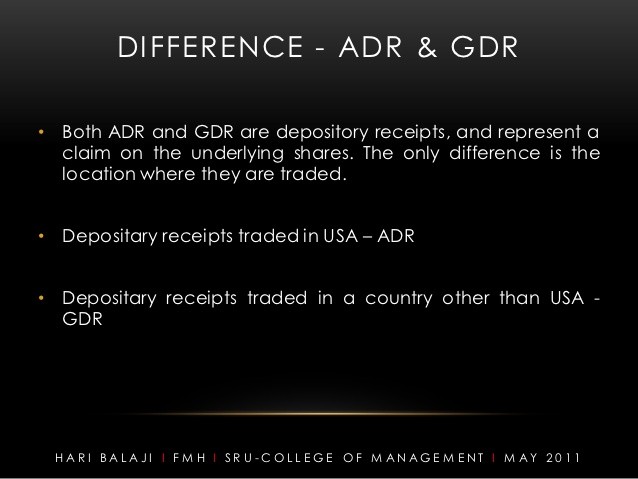PPT On ADR And GDR
Post on: 18 Июнь, 2015 No Comment

PPT On ADR And GDR
Presentation On ADR And GDR
ADR And GDR Presentation Transcript:
1.What is a Depository Receipt?
A Depositary Receipt (DR) is a type of negotiable (transferable) financial security that is traded on a local stock exchange but represents a security, usually in the form of equity, that is issued by a foreign publicly listed company. The DR, which is a physical certificate, allows investors to hold shares in equity of other countries.
One of the most common types of DRs is the American Depositary Receipt (ADR), which has been offering companies, investors and traders global investment opportunities since the 1920s.
2.ADR
An American depositary receipt (ADR) is a stock that trades in the United States but represents a specified number of shares in a foreign corporation. ADRs are bought and sold on American markets just like regular stocks, and are issued/sponsored in the U.S. by a bank or brokerage.
3.Pictorial
4.About ADR
The first ADR was introduced by JPMorgan in 1927, for the British retailer Selfridges Co. The largest depositary bank is the Bank of New York Mellon.
The stock of many non US companies, traded on US exchanges through the use of ADRs.
The shares of the non-US corporation trade on a non-US exchange, while the ADRs trade on a US exchange.
5.Types Of ADR
Unsponserd Shares
Sponsered shares
Level I
Level II
Level III
Restricted programs
144-A
Regulation S
6.The price of an ADR is often close to the price of the foreign stock in its home market
Depository banks have numerous responsibilities to an ADR holder and to the non-US company the ADR represents
7.Steps Towards ADR
U.S. banks simply purchase a bulk lot of shares from the company.
They bundle the shares into groups, and reissues them on either the New York Stock Exchange (NYSE), American Stock Exchange (AMEX) or the Nasdaq. In return, the foreign company must provide detailed financial information to the sponsor bank.
The depositary bank sets the ratio of U.S. ADRs per home-country share. This ratio can be anything less than or greater than 1.
8.Why ADR
ADRs were introduced as a result of the complexities involved in buying shares in foreign countries.
The difficulties associated with trading at different prices and currency values.
Each ADR represents several real shares
9.NASDAQ
10.ADVANTAGES OF ADR
The advantages of ADRs are twofold.
For individuals, ADRs are an easy and cost-effective way to buy shares in a foreign company. They save money by reducing administration costs and avoiding foreign taxes on each transaction.
Foreign entities like ADRs because they get more U.S. exposure, allowing them to tap into the wealthy North American equities markets.
11.Specimen Of ADR
12.Indian ADRs
13.GDR
Global Depository Receipt means any instrument in the form of a depository receipt or certificate created by the overseas depository bank outside India and issued to non- resident investors against the issue of ordinary shares or Foreign Currency Convertible Bonds of issuing company. Among the Indian Companies, Reliance Industries Ltd. was the first company to raise funds through a GDR issue.
14.About GDR
A Global Depository Receipt (GDR) is a certificate issued by a depository bank, which purchases shares of foreign companies and deposits it into the account.
GDRs represent ownership of an underlying number of shares.
15.Global Depository Receipts facilitate trade of shares, and are commonly used to invest in companies from developing or emerging markets .
Prices of GDRs are often close to values of related shares, but they are traded and settled independently of the underlying share.














